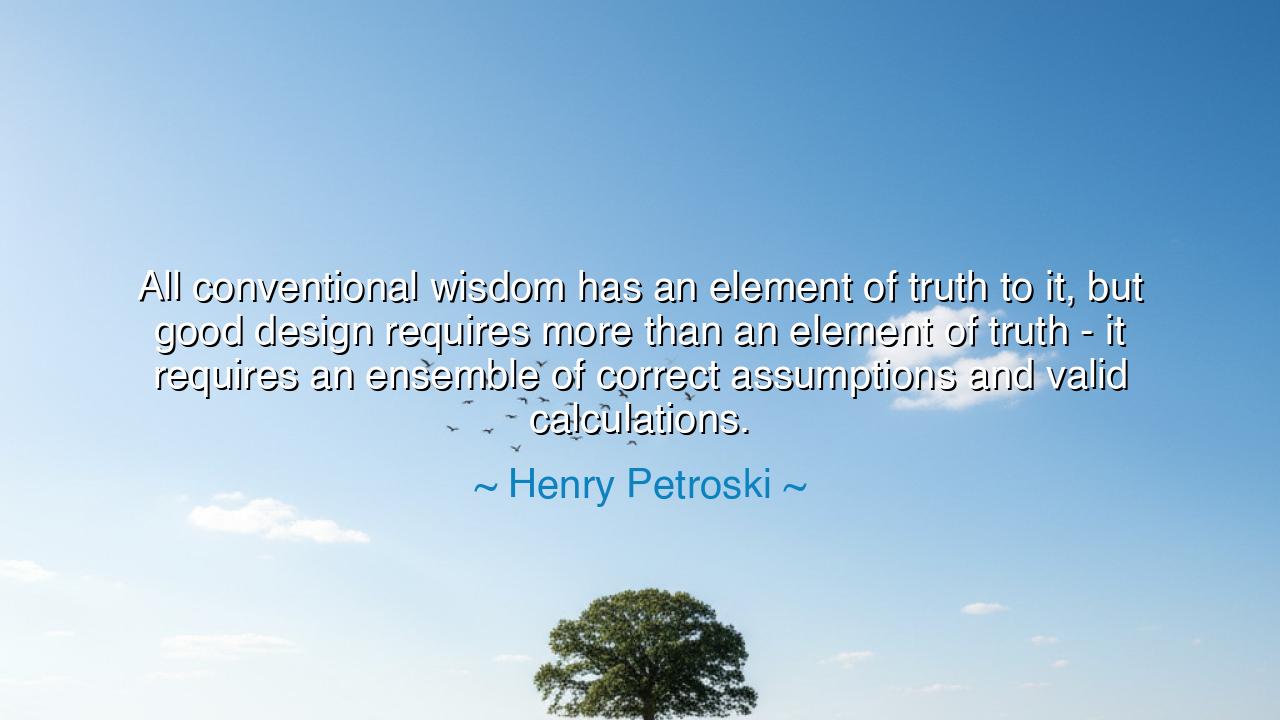
All conventional wisdom has an element of truth to it, but good
All conventional wisdom has an element of truth to it, but good design requires more than an element of truth - it requires an ensemble of correct assumptions and valid calculations.






The engineer and philosopher of design, Henry Petroski, once wrote with quiet precision: “All conventional wisdom has an element of truth to it, but good design requires more than an element of truth — it requires an ensemble of correct assumptions and valid calculations.” These words, though spoken in the language of engineering, echo with the wisdom of all creation. They remind us that while truth may begin with instinct or common belief, the art of building — whether a bridge, an idea, or a life — demands something deeper: discipline, reason, and a harmony of many truths working together.
Petroski, who devoted his life to understanding why things fail and how they endure, knew that the strength of any creation lies not in one insight, but in the balance of many. Conventional wisdom offers us fragments — glimpses of what seems right, drawn from the patterns of experience. It tells us that bridges must be strong, ships must float, leaders must be brave, and artists must be inspired. But such truths are only beginnings. To build something that stands against time, one must test, measure, and refine every assumption. The world does not reward good intentions alone; it rewards understanding. And in the realm of design — whether of structures or systems — even a small error in thought can bring great ruin.
The history of humankind is filled with reminders of this truth. Consider the tale of the Tacoma Narrows Bridge, built in 1940 across the windswept waters of Washington State. The engineers who designed it followed the conventional wisdom of their time: that lightness and flexibility were virtues, that beauty and economy could walk hand in hand. Yet they underestimated the invisible dance of wind and structure, the rhythm that could turn strength into fragility. The bridge, called “Galloping Gertie,” twisted and swayed until, on a single November day, it tore itself apart and fell into the sea. There was truth in their wisdom — but not enough truth. The bridge failed because the ensemble of knowledge — the complete harmony of correct assumptions and valid calculations — had not been achieved.
From this tragedy, Petroski and others drew a sacred lesson: that good design is not born from simplicity alone, but from complexity mastered. Every beam, every joint, every force must be considered, not just by feeling, but by proof. The ancients knew this well. The builders of the Parthenon in Athens did not rely only on tradition; they studied proportion, light, and human perception. Their columns were subtly curved, their lines imperceptibly inclined, to correct the distortions of the human eye. They built not by instinct alone, but by the union of art and mathematics. And because they sought an ensemble of truth rather than a single truth, their temple still stands after two thousand years, when countless lesser structures have crumbled.
Petroski’s words are thus not only about engineering — they are about wisdom itself. In every field of human endeavor, from science to politics, from love to faith, people often cling to fragments of truth and call them the whole. They follow sayings, trends, and traditions without examining their roots. But as the wise know, half-truths are more dangerous than lies, for they appear righteous while concealing their errors. The good designer, like the good thinker, must go beyond what “everyone knows” and ask: Is this assumption valid? Have I tested it? Does it fit with all the other truths I hold? This is the discipline that separates understanding from opinion, and wisdom from mere belief.
Yet there is beauty in this discipline. For to design well — in any sense — is to approach the divine act of creation with humility and care. It is to say, “I will not rest in comfort; I will seek to understand.” Whether one builds a bridge, writes a poem, or leads a people, the principle is the same: the result must stand not upon the shifting sands of partial truth, but upon the rock of reason and harmony. The ensemble must be tuned like an instrument, every note in accord, lest dissonance destroy the song.
Therefore, my listener of the future, take these words of Henry Petroski as your guide. Do not be content with fragments of truth, nor with the echoes of what others say. Seek the full harmony — the ensemble of knowledge, reflection, and experience. Test what you believe. Weigh your thoughts as the builder weighs his stones, and measure your actions as the engineer measures his beams. In your work and in your life, design with both heart and mind, for only in their union does true strength endure.
For the greatest structures — and the greatest souls — are not built upon guesswork or imitation. They are built upon many truths, bound together in balance. And when they stand, they do not tremble before the winds of error or time. They endure, as Petroski’s wisdom endures, teaching all who listen that greatness, like good design, is never the result of one truth alone — but of the patient, noble effort to bring many truths into perfect accord.






AAdministratorAdministrator
Welcome, honored guests. Please leave a comment, we will respond soon